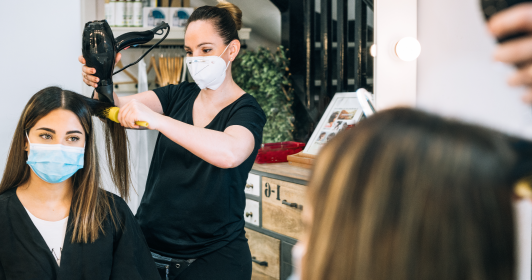
COVID-19 Facts and Prevention Tips
, by Hi-Health, 5 min reading time

, by Hi-Health, 5 min reading time
It's essential to protect yourself by taking precautions, such as social distancing, wearing a mask, and washing your hands. By staying safe, you can prevent the spread of Covid-19 to loved ones and other fellow Americans.

The summer surge of Covid-19 in many states means that the pandemic is far from over. The rates of infection are increasing, and while treatments have improved, there's currently no vaccine for the novel coronavirus.
Covid-19 is primarily spread person-to-person by breathing in contaminated droplets (particles greater than 5 μm) or aerosols (particles less than 5 μm) that are expelled while an infected person is breathing, talking, coughing, or sneezing. Proximity matters so the closer you are to someone, the more likely you'll breathe in whatever they're exhaling, and vice versa.
The CDC recommends 6 feet of physical distance between two people to reduce the risk of infection. This suggestion serves as a practical reference point, but most importantly it's not a safety guarantee.1
Since we cannot see our breath, it is not surprising that most people are unaware of just how easily our breath and the microbes contained within it can spread. When we exhale, a jet of moist air is released from our nose and mouth. Just how far these plumes travel depends on several factors including how the breath is expelled, the droplet size, and the environmental conditions.
Most people were taught from early childhood to cover their mouths when they cough or sneeze. This is sound advice since coughing or sneezing accelerates air out of the respiratory system at a lightning speed of 50 to 100 mph respectively.2 Therefore, coughing or sneezing can disperse the virus quickly if an infected person coughs or sneezes into the air.
Viruses that are in encapsulated in large droplets tend to fall faster to the ground (or surfaces) compared smaller aerosols, which can travel further and linger in the air for as much as 3 hours.3,4
Researchers from Florida Atlantic University recently demonstrated that a cough (a common symptom of Covid-19) can result in 10 μm droplets being expelled as far away as 12 ft.4
Other forms of expiration such as yelling or singing can also expand the radius of exposure to the virus. For example, a single symptomatic person recently infected 53 out of 61 choir members while participating in a choir rehearsal.5 Similar accounts have occurred in other countries.
Evidence suggests that the risk of spreading and catching the novel coronavirus is greater indoors compared to outdoors. While proximity accounts for some of this (people tend to cluster together more tightly indoors) it's not the only explanation. Enclosed spaces with poor ventilation can concentrate the levels of airborne droplets and aerosols making these areas rife for super-spreader events (where one individual infects many others).
The outdoors allows for social distancing. Respiratory particles are exposed to sunlight and humidity to be carried by the wind and dispersed more rapidly and widely. Accordingly, most outside activities that can be done with proper social distancing, such as going for a walk, jog, or bike ride, are relatively safe for you and the community.
For some, wearing a mask may seem restrictive. However, a mask is actually a ticket to lowering your risk of contracting Covid-19.
Research shows that populations with higher mask participation have significantly lower rates of infection and deaths due to Covid-19.6 Surgical masks and homemade cloth versions can directly block large droplets and reduce the momentum of smaller aerosols.6 In essence, masks prevent fewer viruses from being released into the air. More importantly, when you are exposed to the virus, your mask will decrease your risk of breathing in the virus.
The effectiveness of a mask was put to the test in May 2020. Two hairstylists, who were sick with Covid-19 when they went to work and had close contact with 140 clients. Both infected hairstylists wore masks and not one of the clients tested positive for the virus afterward.7 The CDC states that mask-wearing is not a substitute for social distancing which is important, but this study clearly highlights the advantages of wearing a mask.
Many people who contract Covid-19 will show no symptoms. Others may only have mild symptoms that are barely noticeable or indistinguishable from a cold. That's the trouble with coronavirus—people who feel healthy can spread it to others. By wearing a mask, you can help save lives—just like a superhero!
Your mask should cover your face from the bridge of your nose to under your chin. It should stay in place without feeling too tight or irritating your skin. You should be able to talk and breathe easily while wearing your mask.
Hand washing is the simplest way to help mitigate the spread of Covid-19. Viruses on your hands can be transmitted by touching parts of your face such as your eyes, nose, and mouth.
Make sure to wash your hands thoroughly for 20 seconds using soap and water. If you are in public and you’re unable to wash your hands, then a high-quality hand sanitizer made with 70% ethyl alcohol is a good substitute. When cleaning your hands, don't forget to get the fingertips and the thumbs, which are frequently missed!


![PRōZE Review [2020 Update]](http://hihealth.com/cdn/shop/articles/cbd_insider_article_graphic_featured_image-11.jpg?v=1591495027)